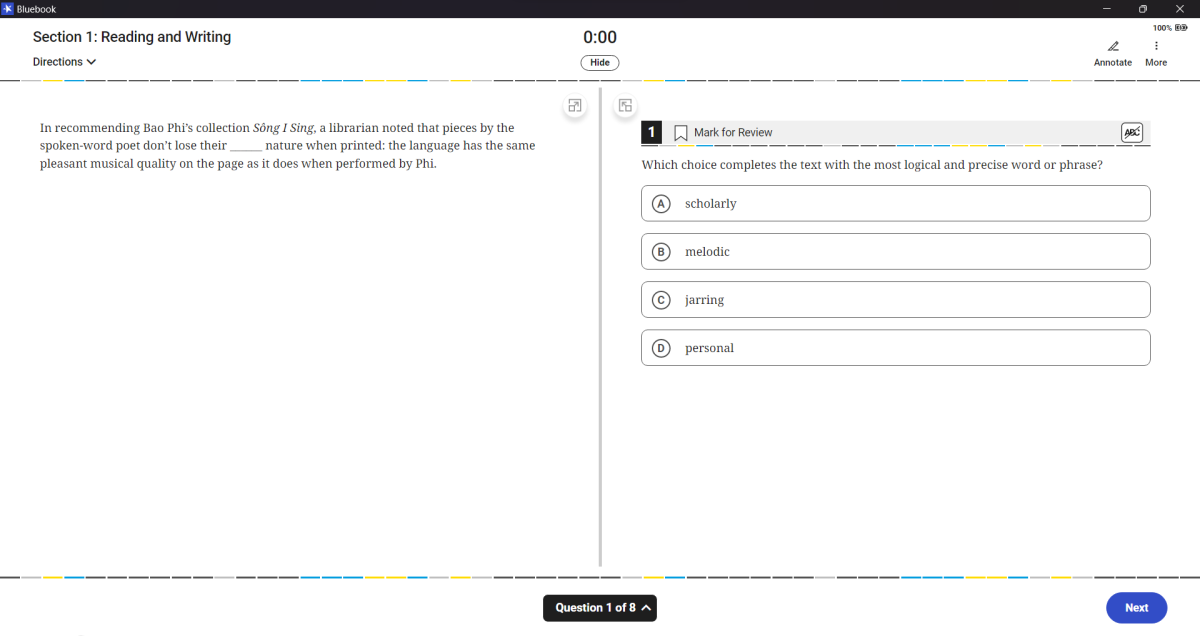Technology has become progressively forced into modern society over recent decades. In education, it is seen as an imposed transition from book to electronic. The most recent subject standing on the chopping block is the Preliminary Scholastic Aptitude Test (PSAT). Instead of familiar paper packets, it is now hosted on an application called Bluebook. OHS students have been forced to adapt to this brand-new system and reevaluate their test-taking strategies entirely.
New features, such as the concept of personalization with tests, sound appealing at first until clear ramifications arise. Each test-taker gets a timer specific to when they begin the PSAT. One student can start late and ultimately prohibit others from enjoying their scheduled breaks.
Breaks depend on the test-taker and are designed for standing up, stretching, eating a snack, or going to the restroom. To limit disruption to the user behind schedule, the rest of the class may be hindered from standing up, for example. They will not get the same experience as other classes, and not as high quality of a break.
According to the University of Southern California, breaks are essential when taking an exam, as they allow the mind to recharge. Mental energy depletes over the duration of the test and can allow more mistakes to be made near the end. Standing up and stretching can improve cognitive function and focus.
Studies have also revealed that students test higher on paper than digitally. Districts that previously scored better scored worse after switching to online. These online districts even performed similarly to the districts with the previously much lower average. Although the reasons are unknown, it is theorized that this is due to different formats or inexperience with the software. Princeton University suggests students also read 20-30% percent slower when using a computer, and their reading accuracy decreases.
Additionally, students must continuously stare at a computer screen for approximately three hours. This extended blue light exposure can cause eye strain and become harmful. According to Harvard, computer screens cause blinking rates to reduce from fifteen blinks per minute to only five or seven times per minute. To protect the eye, there is a thin tear film on its exterior, but blinking insufficiently can dry it. The effects of this eye dryness cause blurry vision and headaches.
With a paper PSAT, students can annotate articles and math problems. Sometimes all a student needs to succeed is to annotate in the margin of their paper or draw on a geometry problem. However, students have access to scratch paper, which makes the process more complicated and inaccessible. The highlight and text annotation tools can help but do not provide the same experience. Some students may have specific ways to work with texts or math problems that the digital version could hinder.
Aside from that, the use of so many computers simultaneously can put more traffic on the network and ultimately slow down sites. This is obviously not optimal with a PSAT relying on an internet connection. It also hinders the rest of the school’s working ability, as they suffer from slow Wi-Fi. Time is also wasted if there are technical difficulties or a computer is not working. Overall, most classes would suffer from this result due to the overreliance on technology.
Although some may suggest that online PSATs are ultimately more eco-friendly, prolonged computer use can create environmentally detrimental electronic waste. E-waste, simply put, is unwanted and broken technological products that get thrown away.
Unfortunately, these items are not disposed of as ecologically responsible as paper materials. The Berkeley Institute states that about 50 million tons of e-waste is produced per year, with only about 15% recycled. In contrast, about 65% of paper is recycled in the United States.
The PSAT paper test was fully recyclable. The paper itself was also more natural than white printer paper, and thus, more biodegradable and environmentally friendly.
The online exam also has a much larger footprint, because a medium computer releases about 500 kg. (approximately 1100 lbs.) of carbon dioxide (CO2) annually. This does not include the monitor and other features. Suggesting this computer is at an average weight of 10 kg. (about 24 lbs.), an equal weight of paper would only produce 10 kg. of carbon dioxide per year. The aforementioned e-waste is also often burned, increasing CO2 emissions.
Not to mention, some students have an SAT right around the corner, an integral part of determining where they go for college. Their practice test shifting drastically in format can affect their scores and therefore, their future. The PSAT was designed on paper for years, why switch now?

![Prom king Colin Napier and queen Leah Hopkins dance the night away during the Golden Gala on April 26th. Prior to the prom, the Student Government must make many preparations over the course of months in order to ensure it goes off without a hitch. However, their work eventually pays off when it comes time for the dance. “We set up [the prom] the day before, and it’s horrible. We’re there for a very long time, and then we get our beauty sleep, and then we get ready for prom the next day,” Aubrie Sandifer said.](https://oviedojournalism.com/wp-content/uploads/2025/05/Oviedo-197-800x1200.jpg)






![Hopkins at Honor Grad with golf coach John McKernan. As Hopkins’ golf coach for the last two years he has seen Hopkins’ growth as a player and person along with their contributions to the team. “[Hopkins] has just been really helpful since I took [the golf team] over, just anything I wanted to do I ran by [Hopkins],” said McKernan.](https://oviedojournalism.com/wp-content/uploads/2025/05/B66A7760-800x1200.jpg)



























